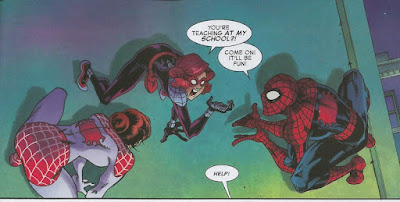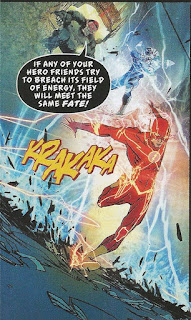Pick of the Brown Bag
February 14, 2018
by
Ray Tate
"This is one of those moments where we just need to step back and count our blessings."
There are 17 blessings not going home, you insensitive offal. #GOPfellatesNRA
Welcome. Time to relax. This week in the Pick of the Brown Bag, I review Amazing Spider-Man: Renew Your Vows, Athena Voltaire, Doctor Who, The Flash, Jupiter Jet, Red Hood and the Outlaws, Sheena, Supergirl, The Titans and Unbeatable Squirrel Girl. Only have time for Twitter-sized reviews? Check out: #PickoftheBrownBag.
Marguerite Bennett and Christina Trujillo launch a new Sheena story. The tale benefits from the continuity provided by the first six issues, but you can read this new chapter one without them. Oh, there was a zero issue. In case, you’re wondering about the discrepancy.
The continuity is simple. Sheena met some outsiders (Cowodi) like Chano, seen above. She fought monsters that she and these outsiders accidentally let into the world and repelled them. Trujillo and Bennett steeped Sheena’s debut in jungle lore. The six issues at once rebooted Sheena and relied on traditional representations.
For this new adventure, the discovery of rot in the jungle takes Sheena back to her village where she consults with Lirio, an old friend and plant gatherer. Lirio’s role is way more important than you may think. She’s the one that searches the forest for medicines and useful botany. She also appears to be crushing on Sheena something fierce, which creates an undercurrent of friction.
Now, I can’t say whether or not this crush is anything but platonic, but much stronger scenes build on the tension, whatever its source. That tension infuses more depth.
At the same time Sheena seeks knowledge about the rot, Cocha the leader of the tribe returns. She informs Sheena that something grave may be tied to the rot.
The huntress Cocha speaks of may also be linked to the manifestation of a monster from South American folklore.
It can be argued that the Mapinguarai symbolizes vagina dentata; with Sheena running from Lirio’s desires and Lirio facing “the monster” and accepting the truth about her orientation. However, this legendary creature is sometimes depicted with that kind of mouth. So, I’m inclined to think that sometimes a monster with an odd smile is just a monster with an odd smile.
Athena Voltaire returns to comics courtesy of Action Lab. Creator/writer Steve Bryant still guides Athena’s adventures during the World War II era and picks up threads he left behind in previous Athena Voltaire volumes. For those not in the know, you’ll quickly catch up. Athena Voltaire is her real name. She’s a classic aviatrix that hires out her plane and her person for various high-stakes ventures.
Love the reaction shots by artist Ishmael Canales. The duo brilliantly codenamed Risk and Reward act as the witnesses to the gist of the plot.
Bryant did his homework. Everything he offers about Pope Sylvester II is based on legend, which may be seeded with fact. In early times, science, mathematics, alchemy and astrology frequently melded rather than clashed, and this Pope definitely was a scholar and scientist.
Bryant takes us to Isola Sacra, Italy, where indeed a Necropolis nests and lets Canales properly introduce the rest of the white hat cast.
Our party delves deeper into the tomb of Pope Sylvester, magnificently reconstructed on the pages. They discover a nice little puzzle and of course, Nazis, that followed the breadcrumbs.
Nazis were highly intelligent, skilled, professional warriors. They possessed but one flaw. They were racist monsters. Today’s Nazis are like particularly stupid babies playing dress up when compared to their ideological ancestors. Stockpiles of guns, political favor and the patronage of Russia make them a threat. Not talent or acumen. Bryant demonstrates Nazi cunning and grants a greater dramatic impetus.
Athena Voltaire is a pragmatist. She knows the Nazis could have easily overwhelmed she and her charges. So, begins the game, with British Intelligence watching ever closely and sometimes upsetting the chessboard.
When last we saw Jupiter “Jacky” Jet she exploded in the sky. Fortunately, the rumors of her death have been greatly exaggerated. She’s instead fished out of the drink by oddball additions to the cast.
That may seem like a cheat. However, writers Jason Inman and Ashley Victoria Robinson quickly dispel the idea by demonstrating Jacky’s ingenuity, which ultimately precluded her untimely demise. A dude aboard The Elara attempts to mansplain Jacky out of that life-saving equipment.
Jupiter Jet is a feminist comic book. For further example we see in the backup set in the past that Jacky wasn’t the first flying female. Other elements in Jupiter Jet are universal. Jacky’s trauma about almost dying carries the issue. An extraordinary woman rescued Jacky from the harbor, but the writers don’t just drop Jacky back to the never-never-land of jet-pack flight.
Instead, they show the mundanity of Jacky’s actions. How she must dry her clothes and lug a heavy useless jet pack around as she makes it home by hitchhiking. Make no mistake. These aren’t really spoilers. Artist Ben Matsuya delivers the impact.
Once home, Jacky decides to quit being the flying girl. Her brother Chuck, the little fellow with the cat, attempts to talk her out of it, but Jacky’s adamant. Fortunately for the reader, forces beyond Jacky’s control coalesce to strap her back into the harness. This is probably the best issue of the impressive series. While still being a lark, it’s also the most dramatic and grander in the complexity of the plot.
Every issue of The Unbeatable Squirrel Girl starts with a Twitter feed. This issue is special for me.
Venom is one of Spider-Man’s lamest foes because in the end he’s just a pair of vicious alien pants. I’ve always said this. Tigra’s first appearance since Battle World, and now the reconnection of Venom to Project Runway. Thank you Ryan North for the corroboration.
Squirrel Girl begins in mid-battle pitting Squirrel Girl against the Silver Surfer. North beefs up the Surfer into a seriously powerful contender and not the weepy simp that mewls about his beloved Shalla-Bal and Zenn-La. He resembles the avatar from Fantastic Four: Rise of the Silver Surfer, and that’s a good thing.
This fight started because the Silver Surfer heard about crimes of planetary larceny he purportedly committed. Of course, the Surfer is innocent. He finally traced the most recent perpetration to the planet of the space squirrels. The book is called Unbeatable Squirrel Girl. So, what did you expect?
Little did the Silver Surfer know that Squirrel Girl already sorted things out with the help of her friends.
The sorting out involved tumbling space-grifters one of whom disguised himself as the Silver Surfer to sell the con.
Things however just got worse. In what appears to be an homage to Hitchhiker’s Guide to the Galaxy, a space armada happens onto the scene ready to nuke the entire planet, squirrels and all. Packed with guest stars, punctuated by an amazing portrayal of the Silver Surfer and driven with jokes galore, this issue of Squirrel Girl is not to be missed.
In Jody Houser’s first title of the week, she checks in with the Parkers: Pete, M.J. and Annie May. The Spider-Man Family. Kicking off the sedate start, Houser peeks at Spidey’s day-job at The Daily Bugle. Things could be better.
This is a great moment with equally impressive artwork—by Nathan Stockman and Ruth Redmond. The scene showcases J. Jonah Jameson’s humanity. He’d clearly like to haggle over more bucks—not necessarily pay out, but his paper isn’t making the revenue that it used to. He’s galled by that. Unfortunately for Annie, this lack of funding triggers a spider-notion.
This isn’t the first time Peter went into teaching. He was a T.A. in college. He taught grade school science. Houser cleverly brings in Peter’s love of the camera for this cycle, and that’s original.
As Spidey and his daughter argue, naturally M.J. must set things right. She displays her abilities as a teacher. She delivers a practical response to Pete and Annie in the midst of issuing a timely gun safety lesson.
With the die cast, Peter goes off to teach, and Annie does her best to avoid him. What can possibly go wrong?
On the bright side, this flash of Spider-Sense isn’t Peter’s fault. On the dark side, villains.
In Supergirl Jody Houser teams up with Steve Orlando to present Kara’s struggle against a new villain.
The Evolutionist looks like the average threat you would find in an inventory issue. Orlando and Houser put some effort into making the character substantial. The Evolutionist's origin is tragic. Her rationale is the Prime Directive gone amok.
She furthermore packs a considerable amount of power, more than enough to make Supergirl take notice.
The Evolutionist attacks the moment the kids at National City Tech hold their Solstice Semiformal Dance. This brings the D.E.O. crashing farther into Kara’s world. Fortunately the Girl of Steel has got this covered.
What a superb variation on the phone booth change, carried out elegantly by artist Carmen Carnero.
Supergirl overcomes the Evolutionist, in an inspired way, but she still must convince not just the D.E.O. but also the people of National City that she supports them.
The epilogue brings Kara closer to a colleague and friend, and I’m ashamed to admit that I didn’t see this relationship budding at all. With the expressions and body language between the two, the intimacy becomes natural.
Central City is frozen in time. The enigma behind the riddle? Gorilla Grodd. Grodd froze Central City to provide an arena for his mental and physical duel against Barry Allen, the Flash. This fight is different from all others. Grodd prepares for every contingency, including the Justice League.
Artist Carmine Di Giandomenico and Ivan Plascencia educe the monster in Grodd and the inhuman in Barry. When the Flash speeds, I believe he ceases to be human, and that’s the gist of this story. Grodd is dying. He intends to rip the Speed Force out of Barry to survive through its regenerative properties.
Barry, being Barry, offers alternative help, but Grodd is having none of it. The plan is to reduce Barry to permanent human and then end him. Though tactically sound, there's really only one rationale behind Grodd's actions. Grodd hates Barry.
Grodd manipulates the truth to his advantage. He wields that falsehood as a psionic bombardment. Grodd’s bias intensifies the dynamic of arch hero vs arch villain. Writer Joshua Williamson also remembers Grodd’s entrance in the New 52 and the promises made. Williamson though shows that he’s actually on Team Flash. He argues that Grodd is wrong about Barry Allen. Grodd’s mistake will cost him dearly.
What I know about Cheshire can fill a thimble, but this is the New 52. In The Titans, Dan Abnett gives Cheshire a fresh start. Originally, Cheshire and Speedy got together and had a child named Lian. There you go. That’s all I’ve got. Abnett erases their child but keeps the dicey past. Cheshire seems to be much grayer in personality than her previous incarnation. Artist Paul Pelletier relishes the chance to render another action protagonist. Now that Cheshire may be working on the side of angels, he also takes the opportunity to show a softer side.
Together Cheshire and Roy break an Intergang drug distribution unit. Intergang, I know. Intergang is exactly what the name implies. An international group of criminals like James Bond’s SPECTRE. Darkseid’s favor distinguishes them. The New God shows his appreciation through alien technology, and that’s why Intergang tended to harass Superman.
As far as I can tell, this is the group’s first appearance in the New 52. Intergang’s connections thus remain unclear. The group is still pretty rough. Only competent heroes can defeat them. So, this is not a job for Ambush Bug or the Inferior Five.
It’s date night for Red Hood and the Outlaws.
Clearly Jason is way below Artemis’ weight class, but is this really a date? Writer Scott Lobdell plays with the concept of will they, or won’t they situations while addressing Bizarro’s unfortunate turn as a synthetic Kryptonite dependent.
Guest artist Marcio Takara provides the ebullience of Jason’s and Artemis’ night on the town. I don't think I've ever seen Artemis smile this much, but the pearly whites still suit her character. Takara demonstrates range with a curious cameo by Lex Luthor, Bizarro’s creator and savior. The artist drops into noir when the plot threads converge on the waterfront.
Doctor Who is the penultimate issue of “Confusion of Angels,” and there’s very little I can say about it without spoilers. The Doctor, Nardole and Bill answered a distress call far into the future. On the freighter, the Doctor’s quickly trussed up then back in charge. Meanwhile, Bill makes a connection with a comely engineer whose doing something that might not be the smartest reprogramming trick, but does it have anything to do with the disappearance of her crew mates?
In Richard Dinnick’s story the confluence of old faces helps make the monster-on-a-spaceship feel like Doctor Who. The way the Doctor and his team interact with various creatures and players increases the suspense, despite the fact that we pretty much know what’s behind the vanishings. The dual nature of the guests creates the possibility of more duplicity, and the dialogue positively rings with with the voices of the stars.
Surprisingly, that’s not Francesco Manna illustrating. Instead, Pasquale Qualano takes over for a smooth transition. Qualano like Manna has an eye for detail and skill for bringing out the likenesses of the cast.










































No comments:
Post a Comment